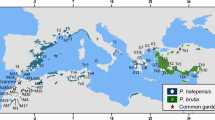Abstract
Melaleuca quinquenervia is a wetland tree species indigenous to eastern Australia. It was separately introduced to east and west Florida as an ornamental, but has since become invasive, dominating several habitat types. We tested the predictions that (1) Australian populations would exhibit more genetic variation than Florida populations, due to founder effect, and (2) high phenotypic plasticity would be found in all populations, due to the wide range of habitats occupied. We compared the phenotypic plasticity and familial variation among three Australian populations, two east Florida, and two west Florida populations in a greenhouse experiment. We grew seedlings collected from different maternal trees in each population under two water levels and three pH levels, reflecting the natural range of water levels and soil pH in Florida and Australian Melaleuca stands. We measured leaf size and shape, growth rate and above-ground biomass of seedlings and determined the components of phenotypic variance (familial, environmental, and their interaction) using univariate and multivariate analysis of variance. All traits showed significant among-population and among-family variation, as well as significant phenotypic plasticity, in response to both water level and pH level changes. Sensitivity to pH was particularly high, presumably because plants were grown under pHs ranging from 4.7 to 7.4, and because pH can influence nutrient availability. Familial variation contains genetic variation, but it may also be confounded with maternal environmental effects. Comparing Australian to Floridian Melaleuca, amounts of familial variation and phenotypic plasticity varied by trait. Overall, Australian Melaleuca had more among-population variation than Floridian Melaleuca, presumably reflecting the wider latitudinal range and longer time for evolutionary change in Australia, but had similar amounts of among-family variation, within any one population. If maternal effects are strong, among-population differences may merely reflect greater environmental differences among Australian sites than Florida sites. Australian Melaleuca had less phenotypic plasticity, possibly due to founder effects in Florida or to subsequent adaptive evolution of phenotypic plasticity in Floridian populations. Floridian Melaleuca shows little loss of familial variation, compared to indigenous Australian populations, and that, in combination with its high phenotypic plasticity, should allow it to continue to colonize new areas successfully.
Similar content being viewed by others
Author information
Authors and Affiliations
Additional information
Electronic Publication
Rights and permissions
About this article
Cite this article
Kaufman, S., Smouse, P. Comparing indigenous and introduced populations of Melaleuca quinquenervia (Cav.) Blake: response of seedlings to water and pH levels. Oecologia 127, 487–494 (2001). https://doi.org/10.1007/s004420000621
Received:
Accepted:
Published:
Issue Date:
DOI: https://doi.org/10.1007/s004420000621




